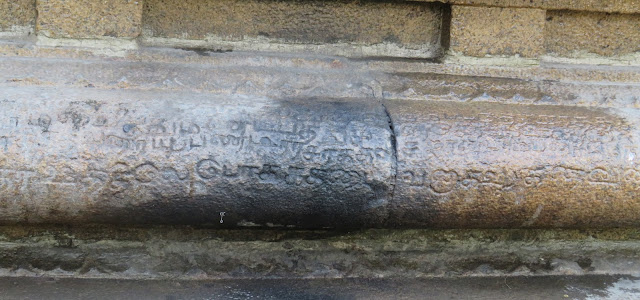Manimangalam Kailasanathar Temple
Manimangalam - if you are an ardent fan of Kalki and have read his "Sivakamiyin Sabadham" novel, it would ring a bell. It was the battlefield where Narasimhavarma Pallava I defeated the Chalukya emperor Pulakeshin II. This battle became a turning point in South Indian history.
Located at about 10 km from Tambaram, it is a fast-growing southern suburb of Chennai. Though the Pallavas got their landmark victory in this village, except for two pillars, no other Pallava-era monument is found. Perhaps, they did not exist. Nevertheless, there are a few Chola-era temples found. Kailasanathar temple, on which this article is written, is one such historic temple.
(Note: I have been visiting the temple since 2014. I have covered this temple in my blog and book in the past. However, I did not feel accomplished. Hence, I decided to write this long article covering details of all inscriptions. As most of the recorded inscriptions are missing now, I thought it is essential to record them in my blog.)
Introduction
Manimangalam is situated at a distance of 10 km west of Tambaram, the southern suburb of Chennai. Google Map location (coordinates) is provided at the end of the article.
Manimangalam has four important and a few other lesser-known temples. Kailasanathar temple, which was in a dilapidated state for a long, is one of those famous shrines. It was completely renovated and reopened in 2012 CE. The renovation is too heavy for anyone to even believe it is originally a Chola-era temple.
History
There were five inscriptions found in the temple. After the renovation of the structure, only one inscription is left, and everything else was lost.
The oldest inscription found in this temple is from Rajaraja Chola I, dated 999/1000 CE. The latest inscription belongs to the 16th century CE from the Vijayanagaras.
Based on the inscriptions that are available to us, we cannot conclude who built this temple. But we can safely assume that the original structure of the temple was built either by Rajaraja Chola or an earlier Chola in the 10th century CE.
The details about all the inscriptions can be seen below. To read the content of these inscriptions, please refer to "South Indian Inscriptions Volume VI".
Inscription # 1
Inscription # 2
Inscription # 3
Inscription # 4
Inscription # 5
Layout
Kailasanatha
The east-facing sanctum (Garbha griha) enshrines a broad and about 3 feet high Shiva Linga called Kailasanatha. He is the presiding deity of the temple.
This is the only Chola-era icon that still exists in this 1000-years old temple. And, the granite base of the sanctum is the only old structure. All other original images and all inscriptions except one were lost when the restoration was done.
Gnanambikai
Koshta Deities
Nardana Ganesha, Dakshinamurit, Lingodbhava, Brahma and Vishnu Durga are the Koshta deities.
Other Deities
The east-facing shrines of Selva Vinayaka and Shanmukha-Valli-Devasena are located in the prakara. Shanmukha with peacock on his back, is an outstanding sculpture, though it is newly made. Valli has lotus in her left arm and Devasena holds lily in her right arm.
Chandikeshwara, Bhairava and Navagraha are the other deities found.
Nandi and bali pitha (offering platform) are located facing the main shrine.




.JPG)
Comments
Post a Comment